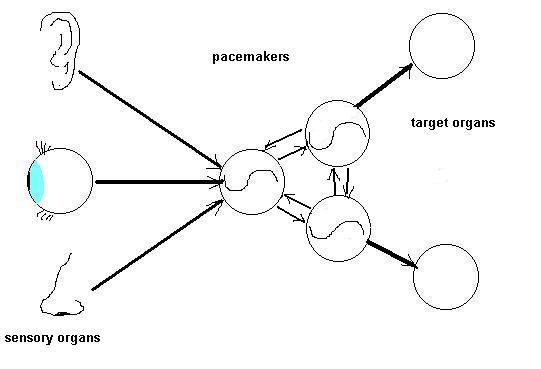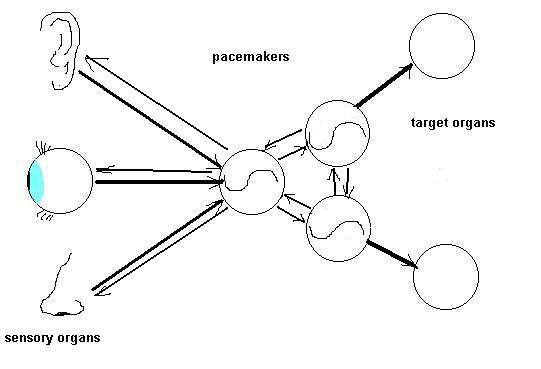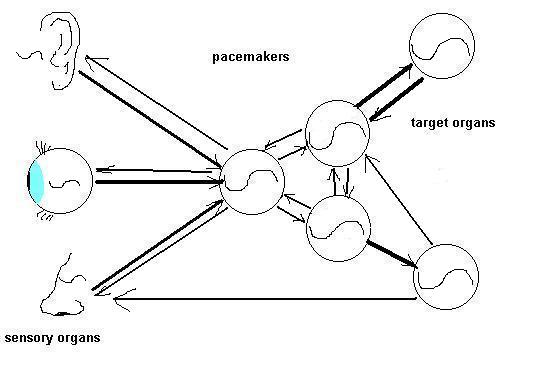ClockTutorial #5: Circadian Organization
In the earliest days of chronobiology, the notion of circadian organization was quite simple. Somewhere inside the organism there was a clock. It was entrained by light via photoreceptors (e.g., the eye) and it drove the rhythms of various biochemical, physiological and behavioral events in the body:

Very soon this simple notion became difficult to sustain in light of new data. For instance, it was recognized early on that enviornmental cycles other than light are capable of entraining circadian rhtyhms. Cycles of environmental temperature and barometric pressure, sound (e.g., consepcific birdsong), and social cues have been shown to entrain circadian clocks in various organisms.

Next, it became apparant that there is more than one clock. For instance, in certain environmental conditions, the circadian rhtyhms would split into two components, each with a different endogenous period. In some organisms it appeared that the organization between multiple clocks was hierarchical, i.e., there was a master-pacemaker whose output was entraining a couple of slave-oscillators.

In other organisms, it appeared that the organization was non-hierarchical, i.e., the several clocks were of equal importance, each influencing all the others, and as a group generating an output that drives all the overt rhythms:

For instance, surgical deletions of potential pacemaking sites in birds revealed the equal importance of the pineal organ and the suprachiasmatic area (in the sparrow), or the retina of the eye and the SCN (in the quail), or the pineal, the eye and the SCN (in the pigeon).
In both the hierarchical and the non-hierarchical models, the various sensory modalities could either all affect only one of the pacemakers, or could be distributed, with for instance, one pacemaker receiving light information, another one being sensitive to temperature, yet another one entrainable by feeding schedules.
The next step was recognition that the information does not necessarily flow in just one direction: from the environment, via sensory systems, to the pacemakers, to the effector organs. It was realized that the clock also generates circadian rhythms in sensory sensitivity. For instance, the eye may be more sensitive to light during the night than during the day, or the ear more sensitive to sounds during the night than during the day. Actually, electroreception is the only sensory modality in which no circadian modulation was found so far.

Other forms of feedback were discovered later. For instance, a rhythm of hormone release from an effector organ could affect the pacemaker - a direct feedback. A behavioral response could feed back on the clock. For instance, in hamsters, circadian clock drives the daily rhtyhm of activity (wheel running), but wheel-running itself shifts the clock. An example of an indirect effect via environment would be a burrowing nocturnal animal that may have a circadian rhythm of activity that also determines its rhythm of exposure to entraining environmetal light cycles. This can be drawn as:

Finally, it was discovered quite recently that every cell in the body contains a clock, i.e., every cell is a peripheral (slave) oscillator. The mollecular machinery is very similar to the one in the pacemaker. However, removal of the pacemaker eliminates all overt rhythms, while removal of peripheral clocks does not. Transplantation of pacemaker tissues also transplants the phase and the period of all overt rhythms of the donor to the host, while transplantation of peripheral clocks leads the transplanted donor tissue to assume the period and phase of the host. When kept in a dish, peripheral clocks damp into arrhythmicity after just a few cycles, while pacemaker cells keep cycling indefinitelly (A piece of mammalian SCN has been cycling in vitro for more than two years - I don't know but it may be still cycling!).

This looks very complicated and it is. Circadian systems are quite complex. Almost all of the current research is devoted to figuring out the details: where are the pacemakers located, what are the molecular mechanisms for generation of circadian rhythms in pacemakers and peripheral oscillators, which pacemaker receieves sensory information from which sensory organs and by which mechanism, what is the chemical nature (neurotransmitters or hormones) of signals between various elements of the system, what are the biochemical cascades leading from the reception of sensory information to the clock machinery and from the clock to the cellular output, etc. And all of this is done in less than a dozen standard laboratory model organisms. This is expensive research and many feel that only NIH grants are substantial enough to cover the expenses. The NIH panellists are unlikely to be enlightened about the importance of evolution to medicine, thus there is, at present, preciously little research on evolutionary aspects of circadian clocks, e.g., comparison between related species, or tests of adaptive function. The new generations of students coming up through graduate school may never have to even think about evolutionary context of their own research, thus perpetuating this situation into the future. As I have argued before, it is neccessary for physiological and evolutionary research to be performed simultaneously, as evolutionary data inform which aspects of physiology are imprtant to study, and physiological data allow for better evolutionary analysis. It is a feedback loop, and a recipe for the fastest progress in the study in any area of biology. Stopping the loop by virtually eliminating one of the poles will inevitably slow down the rate of progress and lead many along blind alleys in their research.
Archives/Categories: Clock Tutorials
Tags: circadian

Very soon this simple notion became difficult to sustain in light of new data. For instance, it was recognized early on that enviornmental cycles other than light are capable of entraining circadian rhtyhms. Cycles of environmental temperature and barometric pressure, sound (e.g., consepcific birdsong), and social cues have been shown to entrain circadian clocks in various organisms.

Next, it became apparant that there is more than one clock. For instance, in certain environmental conditions, the circadian rhtyhms would split into two components, each with a different endogenous period. In some organisms it appeared that the organization between multiple clocks was hierarchical, i.e., there was a master-pacemaker whose output was entraining a couple of slave-oscillators.

In other organisms, it appeared that the organization was non-hierarchical, i.e., the several clocks were of equal importance, each influencing all the others, and as a group generating an output that drives all the overt rhythms:

For instance, surgical deletions of potential pacemaking sites in birds revealed the equal importance of the pineal organ and the suprachiasmatic area (in the sparrow), or the retina of the eye and the SCN (in the quail), or the pineal, the eye and the SCN (in the pigeon).
In both the hierarchical and the non-hierarchical models, the various sensory modalities could either all affect only one of the pacemakers, or could be distributed, with for instance, one pacemaker receiving light information, another one being sensitive to temperature, yet another one entrainable by feeding schedules.
The next step was recognition that the information does not necessarily flow in just one direction: from the environment, via sensory systems, to the pacemakers, to the effector organs. It was realized that the clock also generates circadian rhythms in sensory sensitivity. For instance, the eye may be more sensitive to light during the night than during the day, or the ear more sensitive to sounds during the night than during the day. Actually, electroreception is the only sensory modality in which no circadian modulation was found so far.

Other forms of feedback were discovered later. For instance, a rhythm of hormone release from an effector organ could affect the pacemaker - a direct feedback. A behavioral response could feed back on the clock. For instance, in hamsters, circadian clock drives the daily rhtyhm of activity (wheel running), but wheel-running itself shifts the clock. An example of an indirect effect via environment would be a burrowing nocturnal animal that may have a circadian rhythm of activity that also determines its rhythm of exposure to entraining environmetal light cycles. This can be drawn as:

Finally, it was discovered quite recently that every cell in the body contains a clock, i.e., every cell is a peripheral (slave) oscillator. The mollecular machinery is very similar to the one in the pacemaker. However, removal of the pacemaker eliminates all overt rhythms, while removal of peripheral clocks does not. Transplantation of pacemaker tissues also transplants the phase and the period of all overt rhythms of the donor to the host, while transplantation of peripheral clocks leads the transplanted donor tissue to assume the period and phase of the host. When kept in a dish, peripheral clocks damp into arrhythmicity after just a few cycles, while pacemaker cells keep cycling indefinitelly (A piece of mammalian SCN has been cycling in vitro for more than two years - I don't know but it may be still cycling!).

This looks very complicated and it is. Circadian systems are quite complex. Almost all of the current research is devoted to figuring out the details: where are the pacemakers located, what are the molecular mechanisms for generation of circadian rhythms in pacemakers and peripheral oscillators, which pacemaker receieves sensory information from which sensory organs and by which mechanism, what is the chemical nature (neurotransmitters or hormones) of signals between various elements of the system, what are the biochemical cascades leading from the reception of sensory information to the clock machinery and from the clock to the cellular output, etc. And all of this is done in less than a dozen standard laboratory model organisms. This is expensive research and many feel that only NIH grants are substantial enough to cover the expenses. The NIH panellists are unlikely to be enlightened about the importance of evolution to medicine, thus there is, at present, preciously little research on evolutionary aspects of circadian clocks, e.g., comparison between related species, or tests of adaptive function. The new generations of students coming up through graduate school may never have to even think about evolutionary context of their own research, thus perpetuating this situation into the future. As I have argued before, it is neccessary for physiological and evolutionary research to be performed simultaneously, as evolutionary data inform which aspects of physiology are imprtant to study, and physiological data allow for better evolutionary analysis. It is a feedback loop, and a recipe for the fastest progress in the study in any area of biology. Stopping the loop by virtually eliminating one of the poles will inevitably slow down the rate of progress and lead many along blind alleys in their research.
Archives/Categories: Clock Tutorials
Tags: circadian






0 Comments:
Post a Comment
<< Home